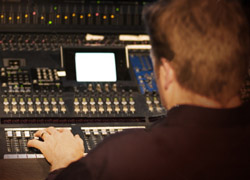
But over the past few years, “active” splitters have come on the market, both lighter and less expensive than their transformer brethren.
However, the signal is still running through electronics, so the frequency response, slew rate and bandwidth of those circuits is going to become part of the sound of your recording – before the signal even gets near a mic preamp.
Note that this is not necessarily a bad thing, but something that should be considered and tested rather than implemented blindly.
So now we have our microphone level signal running in three directions – one for the band, one for the audience, and one for posterity.
Or, it might be only two directions – many consoles have “direct outputs”, which can often be taken directly from the console’s mic-pre, pre-EQ and fader.
For the recording, it’s a good idea to avoid the EQ, compression, and especially fader moves employed during a live performance.
If a gate doesn’t open on a drum hit here or there during a live performance, or if a vocal is overly compressed a bit, it’s usually not the end of the world. But these types of things create more significant problems on a recording.
What is desired is the full-range microphone signal with no processing so the recording can be manipulated later. Unless you can monitor your processing as you’re recording it and can be 110 percent “sure” that it fits the music, don’t use it.
One of my mentors as I was learning the craft had a saying: “when in doubt, leave it out”.
There is a problem with digitally based recording in that you can’t exceed a maximum level (0dbfs), so you may want to employ a very momentary “peak limiter” on each channel.
Some analog to digital (A/D) converters have these limiters built into them, but that, my friends will be discussed later on down the road.
Fletcher has worked in professional audio for more than 30 years, and moderates a popular REP Forum on ProSoundWeb.
